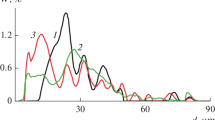Abstract
The processes leading to the formation of toxic beryllium-containing aerosol particles at the stages of beryllium hydroxide production using a new innovative technology of ore processing at the Ermakovskoe deposit are considered. In order to create a conceptual structure of experimental samples of the units for control emissions and discharges of pollutants in the production of beryllium hydroxide, the processes of aerosol formation at various technological stages of beryllium production have been studied. A diffusion model is proposed for droplet evaporation during the leaching and hydrolysis of beryllium concentrates, which makes it possible to determine the rate of evaporation, temperature, size, and lifetime of a droplet depending on the environmental conditions. The results of model calculations (for the diffusion model) of the dispersed composition of beryllium-containing aerosol particles are presented. The most hazardous stages of emissions and discharges of beryllium-containing aerosols in the production of beryllium hydroxide according to a new technology have been identified; the ecological risks arising during emissions of aerosol particles into the atmosphere are assessed.








Similar content being viewed by others
REFERENCES
Beryllium and Beryllium Compounds (Concise International Chemical Assessment Document 32), Geneva: World Health Organization, 2001.
Beryllium (Environmental Health Criteria 106), Geneva: World Health Organization, 1990.
Beryllium: Environmental Analysis and Monitoring, Brisson, M.J. and Ekechukwu, A.A., Eds., Cambridge: Royal Society of Chemistry, 2009.
Bird, J.C., Ruiter, R., Courbin, L., and Stone, H.A., Daughter bubble cascades produced by folding of ruptured thin films, Nature, 2010, vol. 465, pp. 759–762. doi 10.1038/nature09069
Fedorov, V.D., Kotsar’, M.L., et al., Sposob polucheniya gidroksida berilliya (Beryllium Hydroxide Derivation Method), RF Patent 2264986, 2005.
Filov, V.A., Beryllium and its compounds: Environment, toxicology, and hygiene, Russ. Khim. Zh., 2004, vol. 48, no. 2, pp. 76–86.
GOST 12.1.007-76.SSBT. Noxious substances. Classification and general safety requirements, January 1, 1977.
GOST R 54597-2011. Workplace atmospheres. Ultrafine aerosols, nanoparticle and nano-structured aerosols. Inhalation exposure characterization and assessment. January 12, 2012.
http://www.ulba.kz/ru/industry2.htm. Accessed September 24, 2015.
Kislov, E.V., Imetkhenov, A.B., and Sandakova, D.M., The Ermakov fluorite–beryllium deposit: Ways for increasing the ecological safety of recovery, Geogr. Prir. Resur., 2010, no. 4, pp. 30–36.
Kolbasov, B.N. and Kurbatov, D.K., Safety of handling beryllium and its waste materials on the ground of thermonuclear facility, Vopr. At. Nauki Tekh., Ser.: Termoyad. Sint., 2003, no. 3, pp. 32–60.
Kol’tsov, V.Yu., Development of innovation technology for deriving beryllium-containing concentrates and beryllium hydroxide out of mineral and technogenic raw materials, in Nauch.-prakt. konf. po itogam realizatsii v 2015 godu prikladnykh nauchnykh issledovanii i eksperimental’nykh razrabotok v ramkakh Federal’noi tselevoi programmy “Issledovaniya i razrabotki po prioritetnym napravleniyam razvitiya nauchno-tekhnologicheskogo kompleksa Rossii na 2014-2020 gody” v ramkakh Ezhegodnoi natsional’noi vystavki-foruma “Vuzpromekspo-2015”, g. Moskva, 02–04 dekabrya 2015 g. (Scientific and Practical Conference Summarizing the 2015 Results of Applied and Experimental Research within the Federal Target Program “Research and Development on Priorities for the Advancement of Russian Science and Technology in 2014–2020”, within the Annual National Exhibition–Forum “Vuzpromekspo-2015”, December 2–4, 2015), Moscow, 2015.
Matyasova, V.E. and Kotsar’, M.L., Derivation, properties, and use of high-purity beryllium compounds, Vopr. At. Nauki Tekh., 2014, vol. 90, no. 2, pp. 111–119.
Matyasova, V.E., Kotsar’, M.L., Kochubeeva, S.L., and Nikonov, V.I., Derivation of beryllium materials for nuclear and thermonuclear power engineering out of beryllium-containing waste, Vopr. At. Nauki Tekh., 2013, vol. 84, no. 2, pp. 110–117.
Matyasova, V.E., Kotsar’, M.L., Anan’ev, A.V., Alekberov, Z.M., and Bykov, A.D., Ion-exchange processes in the reprocessing of sulfate solutions and pulps with production of high-purity beryllium compounds, At. Energy, 2016, vol. 119, no. 6, pp. 408–413.
Mednikov, E.P., Turbulentnyi perenos i osazhdenie aerozolei (Turbulent Transport and Deposition of Aerosols), Moscow: Nauka, 1981.
Samoilov, V.I., Technological processes of comprehensive processing of beryllium–lithium mineral raw materials, Extended Abstract of Doctoral (Tech.) Dissertation, Ekaterinburg: Ural Federal University named after the first President of Russia B.N. Yeltsin, 2010.
Venetskii, S.I., Metall kosmicheskogo veka: Rasskazy o metallakh (The Metal of the Cosmic Era: Stories About Metals), Moscow: Metallurgiya, 1979.
Vrednye veshchestva v promyshlennosti: Spravochnik dlya khimikov, inzhenerov i vrachei (Harmful Species in the Industry: A Reference for Chemists, Engineers, and Physicians), vol. 3: Neorganicheskie i elementoorganicheskie soedineniya (Inorganic and Organoelement Compounds), Lazarev, N.V. and Levina, E.N., Eds., Leningrad: Khimiya, 1977.
Walsh, K.A., Beryllium Chemistry and Processing, ASM International, 2009.
White, D. and Burke, J., The Metal Beryllium, Cleveland: American Society for Metals, 1955; Moscow: Inostrannay literatura, 1960.
Zelenin, V.I., Samoilov, V.I., et al., Sposob polucheniya gidroksida berilliya (Beryllium Hydroxide Derivation Method), RF Patent 2353582, 2008.
Zhulanov, Yu.V. and Petryanov, I.V., Study of the mechanism for the generation of marine aerosols, Dokl. Akad. Nauk SSSR, 1980, vol. 253, no. 4, pp. 845–848.
ACKNOWLEDGMENTS
This work was performed under the Development and Production of Experimental Samples of Units Controlling Emissions and Discharges of Pollutants in the Production of Beryllium Hydroxide (Agreement no. 14.579.21.0098 on Granting a Subsidy, unique identifier RFMEF157915X0098) implemented in accordance with the Federal Targeted Program Research and Developments in the Priority Areas of Development of the Russian Scientific and Technological Complex for 2014–2020.
Author information
Authors and Affiliations
Corresponding authors
Additional information
Translated by L. Mukhortova
Rights and permissions
About this article
Cite this article
Obvintsev, Y.I., Gubanova, D.P. & Minashkin, V.M. Processes of Formation of Beryllium Hydroxide Aerosols and Assessment of Ecological Risks Arising during Their Emissions to the Environment. Izv. Atmos. Ocean. Phys. 54, 667–677 (2018). https://doi.org/10.1134/S0001433818070071
Published:
Issue Date:
DOI: https://doi.org/10.1134/S0001433818070071




